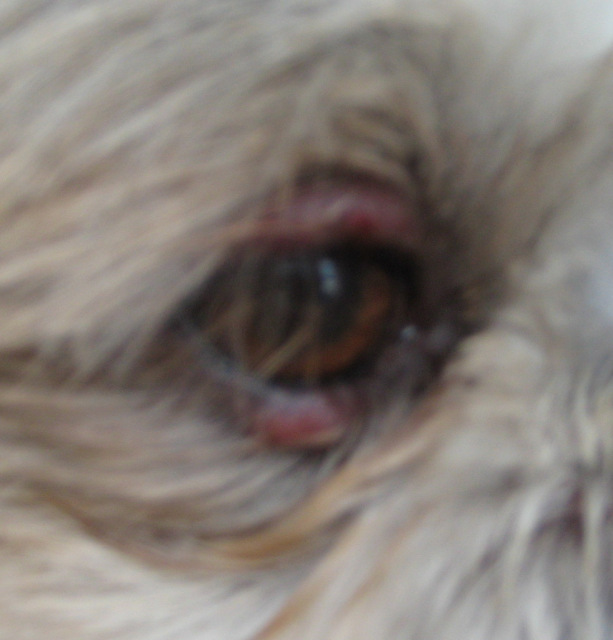Question------------------------been there done that, he said put them to sleep. i am trying la200 infectable, anything else.-
Followup To
Question -
I have an australian sheparh female with border collie puppies at 4 weeks old. thay all have a skin problem, some much worse than others. their feet and legs and tail have hair off and somewhat swollen. one has a few sore spots on his back. Can you tell what this is and what can be done to treat it? thanks ken
Answer -
Hi Kenneth!
They all need to get a veterinarian immediately as this can be a very bad skin disease in all of them.They can get worse and sicker if not taken to the veterinarian immediately.This can be many things like hotspots,parasites,heart trouble or even cancer.They all need a good veterinarian immediately!
If you do not have enough money for a vet,maybe your vet can make a deal with you.Ask him if you can make dow payments every week or months with like $10,for example,until you are payed off.These animals need a vet.
I hope this has been helpful and I wish you the best of luck!Please keep me posted and give that mama dog and her puppies millions of kisses for me!Sending wagging tails your way!
Nicole
AnswerHi Kenneth!
With the exception of a few hairless breeds, all dogs and cats have a smooth, even coat, no matter what their age. If your pet is developing bare spots or has a patchy, moth-eaten look, there is almost certainly something wrong -- anything from parasites to infections, nutritional deficiencies to hormonal problems.
It is almost impossible to tell at home what is causing fur to fall out, but you can get a few clues from the appearance of the coat.
Pets with circular patches of red or crusty skin, for example, often have ringworm, a type of fungus that is readily passed from pet to pet. Ringworm occurs throughout the country, but it is most common in places with hot, steamy weather. Cats are more likely than dogs to get ringworm. In addition, some cats may be asymptomatic carriers, meaning that they can spread the fungus without having symptoms themselves.
Fur loss in dogs is sometimes caused by demodex mites. These are tiny parasites that normally live peacefully in the hair follicles of dogs. But sometimes the mites multiply -- and when they do, they can cause substantial hair loss. The hair loss starts around the eyelids, mouth, and front legs, causing bare patches about an inch around. Eventually, the patches may enlarge, causing very large bare patches that often get infected.
When your pet is scratching hard enough to make the fur fly, you should always suspect fleas. Another itchy condition is seborrhea, in which oil glands in the skin get overactive, causing greasy, foul-smelling fur and bare patches that may resemble those caused by ringworm.
A thinning coat can be caused by a hormone imbalance. Too little thyroid hormone, for example, will cause hair to fall out all over your pet's body, and the hair that remains will be brittle and coarse. Too much estrogen can have the same effect.
Nutritional deficiencies are rare these days, but they do occur and can cause hair loss or a dull, thin hair coat. Pets that don't get enough protein or essential fatty acids may develop a dry, thin coat, he explains. Nutritional deficiencies generally happen when people don't feed their pets commercial pet foods, most of which are formulated to meet your pet's nutritional needs, and instead rely on table scraps. And if you are feeding your pet a generic food, you might want to upgrade her to a brand-name chow.
In addition, some Arctic breeds like Siberian huskies and Alaskan malamutes have a genetic tendency to absorb too little zinc. This can cause hair loss along with scaly, crusty patches on the skin.
See Your Vet If...
The skin has circular patches that are red and crusty
Your pet is always itchy
Her fur is brittle and coarse
Your pet is shedding or scratching more than usual
He has scales, bald patches, or a rash
He has severe dandruff or dry skin
His fur is greasy or smelly even after baths
Your pet has broken out in hives and is having trouble breathing
He has a bad sunburn
There has been a significant change in skin color, or the skin seems loose
There is a lump or swelling beneath his skin
Your pet has a sore on the skin that won't heal
The skin of the lips, abdomen, or rectal area is yellow
There are red or purple dots or splotches on his skin
One way to find out if your pet has ringworm is to shine an ultraviolet light on her coat. These lights, available from plant and garden stores, will often cause the infected areas to glow green. The test isn't always effective, however, so the lack of a jolly green glow doesn't necessarily mean that your pet is ringworm-free. And other substances on your pet's fur, like medications or natural skin oils, may also glow.
To eliminate ringworm, put on a pair of gloves and clip around the infected area with blunt scissors or clippers. Be careful not to touch yourself or other pets with the gloves or the clipped hair because ringworm is highly contagious -- to people as well as to pets. After the clip job, wash your pet's entire body with an antifungal shampoo. Let your pet air-dry so as not to rub the product off.
You don't need special equipment to recognize fleas, of course, but it can take an army to get rid of them. Once your pet is infested, you might want to take a combination approach, using flea shampoos, powders, and possibly oral medications to get their numbers down.
Seborrhea is not always easy to control.But you can keep it at a dull roar. When you first notice that your pet's coat is getting greasy, wash her once a week with an oil-dissolving shampoo, available in pet supply stores. This will keep her coat comfortable and help reduce the itching.
Finally, be sure to feed your pet a name-brand, quality food. For most pets, this will provide all the nutrients that they need to keep the coat healthy. In some cases, your vet may recommend giving supplements as well. Severe illnesses will increase your pet's need for vitamins and minerals, so supplements may be prescribed along with the other drugs necessary to cure the primary problem. Those breeds that don't readily absorb zinc may be given zinc supplements to keep the coat healthy.
When your pet's fur doesn't improve within a few weeks with home treatments, you are going to need professional help. The first thing your vet will want to know is if the Fur loss is caused by a skin problem or something else. He will probably begin by taking a skin scraping. Viewed under a microscope, this will reveal whether or not your pet has parasites.
Mite infestations can be very difficult to treat, and you are going to need your veterinarian's help. Your pet may be given an anti-parasitic dip at your vet's office every two weeks for at least six weeks. She may need injections of an anti-parasitic medicine as well.
Ringworm and seborrhea can usually be treated at home under the direction of a veterinarian. When baths and ointments don't help, however, your vet may recommend using an oral medication and possibly a steroid ointment to control itching and inflammation.
When Fur loss isn't caused by skin problems, your vet will recommend a blood test to check for a hormone imbalance. He may recommend x-rays or ultrasound as well since some hormonal problems are caused by tumors in the reproductive organs or elsewhere in the body.
Most hormonal problems can be controlled with medications, although in some cases surgery -- either to neuter your pet or to remove tumors -- will be needed. See also: Color changes | Skin crusts and scabs
A few common causes of skin and coat conditions are allergies, autoimmune conditions, fleas, hair-follicle cysts, hormone imbalance, mites, ringworm, seborrhea, skin cancer, and skin infections. Learn more about these common conditions now.
Allergies
You can spot people with allergies because they are the ones blowing their noses and wiping their eyes. Pets with allergies, on the other hand, get very itchy. And the worse the allergy is, the more furiously they scratch.
Dogs and cats can develop allergies to just about anything, including pollen or ingredients in their food. Allergies can cause serious discomfort, and some pets will scratch themselves raw. It is worth taking a little time to figure out what is putting your pet's hind leg in perpetual motion.
One way to tell what kind of allergies your pet has is to watch where he scratches. Allergies to pollen usually cause itching around the armpits, paws, or head. Flea allergies usually cause itching on the back near the tail, he adds. And food allergies can cause itching almost anywhere on the body.
Once you know what is causing the itching, you will have to find ways to help your pet avoid it. In the meantime, vets often recommend giving an antihistamine, which will help relieve itching and other allergy symptoms. For dogs, Benadryl can be very helpful. The usual dose is one milligram for every pound of dog, three times a day. For cats, vets recommend Chlor-Trimeton, which contains an antihistamine called chlorpheniramine that is safer for cats. You can give half of a four-milligram tablet for every 10 pounds of cat, twice a day, she says. To be safe, check with your vet before giving human medications to pets.
Autoimmune Conditions
The immune system is constantly battling foreign invaders like bacteria and viruses, and usually it does a good job fending them off. But in pets with autoimmune conditions such as lupus, the immune system loses its aim. Rather than only attacking germs, it also goes after the body's healthy tissues. In dogs and cats, it is often the skin that gets in the line of fire, resulting in painful sores or blisters that seemingly come out of nowhere.
Autoimmune conditions may affect the whole body and can be difficult to treat. Vets often recommend applying hydrocortisone or other anti-inflammatory ointments to soothe the skin. You can also give your pet periodic soaks in a soothing mix of cool water and colloidal oatmeal (like Aveeno). In the long run, however, pets with autoimmune problems generally need more powerful treatments, such as oral medications that suppress the immune system and keep the attacks under control.
Fleas
Some pets get fleas and never seem to mind. But many dogs and cats are actually allergic to fleas -- even one bite can make them intensely itchy.
Fleas have always been tough to get rid of. In the past, the only effective treatment was to use a combination of sprays, powders, shampoos, collars, and other products. But in recent years researchers have developed new flea products -- such as the oral medication Program or a topical medication like Advantage -- that are much more effective than their predecessors. It is worth using these new products, and not only because of the itching. Fleas are the main carriers of tapeworms. Pets with fleas are constantly licking or biting their coats. When they swallow an infected flea, they will get infected with tapeworms as well.
Hair-Follicle Cysts
Every hair on your pet's hide grows out of a tiny structure in the skin called a hair follicle. Sometimes these follicles get plugged with microscopic bits of skin or hair. This causes them to swell like little balloons, forming lumps beneath the skin. These lumps, called hair-follicle cysts, can be as small as the point of a pen or as large as the end of a crayon.
Finding a lump is always scary, but hair-follicle cysts aren't cancer. They aren't usually painful, and they don't cause long-term problems. And these cysts may go away on their own once they break open and drain. Don't try to get rid of them by squeezing because that can cause an infection beneath the skin.
Hormone Imbalance
Hormones are extraordinarily powerful chemicals. Even tiny amounts can have powerful effects, which is why veterinarians use sophisticated tests to make sure that the body is producing the proper amounts. But you can also spot some hormonal problems at home. For example, when the thyroid gland fails to produce enough of the hormone thyroxin, your pet may lose hair or develop dry, flaky skin.
Another hormonal problem, called Cushing's disease, occurs when the adrenal gland produces too much cortisol. This can cause symptoms ranging from excessive thirst and frequent urination to a distended belly. In addition, pets with Cushing's disease tend to get sick a lot because it weakens the immune system.
It doesn't happen often, but pets that produce too much estrogen may lose fur along their flanks and belly, and their remaining fur may feel greasy. High estrogen levels are sometimes caused by ovarian cysts in cats and testicular tumors in male dogs or cats. Conversely, spayed females will occasionally produce too little estrogen. This also causes the fur to get thinner. In addition, the underlying skin may get thin and fragile.
There are different treatments for hormone imbalances, depending on the hormone and on whether your pet is producing too much or too little. Pets with low amounts of thyroid hormone usually need to take supplements for the rest of their lives. Cushing's disease is often treated with drugs that cause the adrenal gland to produce less cortisol. Pets with high estrogen levels, on the other hand, often need surgery because this condition is usually caused by tumors. Once the tumor is removed, estrogen levels should return to normal. Pets that produce too little estrogen, on the other hand, are better left untreated because estrogen supplements can cause dangerous side effects.
Mites
Mites are microscopic parasites that live on your pet's skin. There are several kinds of mites, including demodex and sarcoptic (scabies) mites. Demodex mites are permanent residents in your dog's hair follicles. (They live on humans, too, in the eyebrow follicles.) Most of the time, they are not a problem. But when your dog gets sick or stressed, his immune system gets weaker, which allows demodex mites to get stronger.
Demodex mites don't cause much itching, and mild cases will usually go away on their own. But a bad case can cause bacteria to attack the skin resulting in painful, open sores. It can take a long time -- using medicated shampoos, antibiotics, and other medications -- to get demodex under control.
Sarcoptic mites, on the other hand, cause pets to scratch themselves silly. Crusty patches may appear around the ears, elbows, and legs. This condition, also known as scabies, is often tough to diagnose. But once your vet knows that it is the problem, it is usually easy to treat.
Dogs and cats with scabies usually need a series of insecticidal dips. In some cases, your vet may use oral medications to fight the mites from the inside out.
Ringworm
Ringworm is a fungus that can wreak havoc on your pet's skin and coat, especially in adolescent dogs and cats. It often causes fur to fall out in circular patches, and the skin underneath can get red and crusty. And because it is contagious, you will rarely have just one pet with ringworm -- other pets in the family can catch it, too. So can the human members of the family. That is why it is important to wear disposable gloves and to wash your handsoften when treating pets with ringworm.
Despite its ugly appearance, ringworm isn't particularly uncomfortable, but it can take a long time to go away. Most pets will need anti-ringworm dips or shampoos, and possibly oral medications. Be very careful to keep young children away from ringworm-infected pets because the infection can spread quite easily to them.
Seborrhea
Some pets have oil glands that are perpetually overactive. They churn out far more oil than the skin needs, particularly on the elbows, ankles, and around the ears. This condition, called seborrhea, results in greasy scales. Bacteria and yeast flourish on these scales, which is why pets with seborrhea often have an unpleasant odor.
Seborrhea usually accompanies other, more-serious conditions, like hormonal imbalances or infestations with parasites, although some pets seem to get it for no clear reason.
Seborrhea isn't dangerous, but it can make your pet very itchy and increase his risk for skin infections. Bathing your pet every week with an oil-dissolving shampoo can be a big help when you are treating seborrhea.
Skin cancer
Dogs and cats don't spend their days on beach towels ordering margaritas and working on their tans. But many pets love the sun, and it is just as dangerous for them as it is for people. Too much sun exposure can dramatically raise the risk for skin cancer, especially on lightly furred areas -- around the mouth, for example, or on the tips of the ears.
In people, cancerous skin changes are easy to see. In pets, however, fur often masks the problem until it is well-advanced and much more dangerous. Vets recommend periodically giving your four-legged sun-worshipper a careful once-over, parting the fur and looking for areas that are darker than the surrounding skin or for sores that never seem to heal.Any change in color should be checked by a vet right away.
Skin Infections
Skin infections usually aren't serious, but they can make dogs and cats itchy and sore. Dogs get skin infections much more often than cats, and some breeds, like bulldogs and shar-peis, get them the most because their wrinkly skin traps moisture and infection-causing bacteria.
You can prevent or reduce some skin infections by periodically bathing your pet with a medicated shampoo.Different ingredients are used for different types of infections, so be sure to ask your vet which product is best for your pet.
I hope this has been helpful and I wish you the best of luck!Please keep me posted and give that mama dog and her puppies millions of kisses for me!Sending wagging tails your way!
Nicole

 Shih-Tzu eyelide problem
Question
swollen eyelids
Hi,
Its been about 2 weeks no
Shih-Tzu eyelide problem
Question
swollen eyelids
Hi,
Its been about 2 weeks no
 Chihuahua & eye issue
Question
redeye
Hi. Firstly, thank you for taking the t
Chihuahua & eye issue
Question
redeye
Hi. Firstly, thank you for taking the t
 labor in dogs
QuestionQUESTION: My female pomapoo went into labor aro
labor in dogs
QuestionQUESTION: My female pomapoo went into labor aro
 kitten with bloody stool
QuestionQUESTION: i have a kitten here, about 2-3 month
kitten with bloody stool
QuestionQUESTION: i have a kitten here, about 2-3 month
 cats lip
Question
swollen lip
Hi there. I dont know if th
cats lip
Question
swollen lip
Hi there. I dont know if th